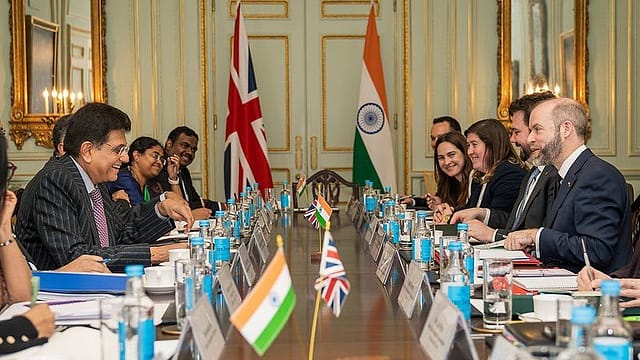India-UK free trade pact marks a historic breakthrough, but its real impact hinges on implementation timeline
ADVERTISEMENT

After three years of formal talks, India and the UK successfully concluded the negotiations for a Free Trade Agreement (FTA) on May 6. Prime Minister Narendra Modi termed it as a ‘historic milestone’, while his counterpart, Keir Starmer, Prime Minister of the UK, saying that it has heralded ‘a new era for trade and the economy’.
As far as India is concerned, the FTA will provide zero duty access to 99% of the goods exports from the country to the UK. The FTA will have a positive impact on manufacturing across labour and technology intensive sectors and opens up export opportunities for sectors such as textiles, marine products, leather, footwear, sports goods and toys, gems and jewellery, engineering goods, auto parts and engines, and organic chemicals. A host of services including financial services, professional services, other business services, and educational services will benefit from the services-related commitments in the FTA and also the Double Contribution Convention (DCC) that will be signed along with the FTA. The DCC provides exemption for Indian workers who are temporarily in the UK and their employers from paying social security contributions in the UK for a period of three years.
For the UK, the deal will slash Indian tariffs on key products such as whisky, cosmetics and medical devices, locking in reductions on 90% of tariff lines for the UK's exports to India, with 85% of these becoming fully tariff-free within a decade. Whisky and gin tariffs will be halved from 150% to 75% before reducing to 40% by year 10 of the deal, while automotive tariffs will go from over 100% to 10% under a quota.
January 2026
Netflix, which has been in India for a decade, has successfully struck a balance between high-class premium content and pricing that attracts a range of customers. Find out how the U.S. streaming giant evolved in India, plus an exclusive interview with CEO Ted Sarandos. Also read about the Best Investments for 2026, and how rising growth and easing inflation will come in handy for finance minister Nirmala Sitharaman as she prepares Budget 2026.
“It matters when the fifth and sixth largest economies in the world reach a trade agreement. Such an agreement is illustrative of the positive momentum in the UK-India relationship, the commitment and ambition of both governments, and the opportunities for greater trade, investment and collaboration between our countries”, says Richard Heald, Chair, UK India Business Council.
The FTA text is not in the public domain, but chapter-wise summaries are known. The chapters include one on anti-corruption, which will require India and the UK to reinforce their international obligations on bribery and corruption at the UN and work together to tackle these global issues within the trade and investment context. The second chapter will talk about ‘temporary movement of natural persons’ and ease work and business-related travel of citizens of both the countries. The third section—the core text, as the UK government’s summary of the FTA text says—provides for an appropriate set of legal relationships between the agreement and other international agreements, and sets out a series of definitions that will be used across the agreement. ‘Final Provisions’ that will set out processes for the entry into force, amendment, and, if appropriate, termination of the agreement will also be a part of this section. Competition and consumer protection, customs and trade facilitation, trade and development cooperation, digital trade, dispute resolution, and environment protection will all be covered under specific chapters of the agreement. There will be a chapter on financial services and one on market access (tariff reduction). The FTA will also talk about how good regulatory practices, government procurement, innovation, intellectual property, labour, MSMEs, public enterprises, subsidies, technical barriers to trade etc will all be dealt with by the partner countries.
Going by the statements from both negotiating partners and industry stakeholders, the agreement is going to be mutually beneficial. If that is the case, by when will it get implemented?
Some procedural steps need to be followed.
First of all, India and the UK have only agreed upon the broad parameters and the draft text. The countries will have to first finalise the text. Each and every word will have to go through legal vetting from both sides. Once that is done, the governments will sign the treaty. The FTA will also require approval from the UK's Parliament before it comes into force. The date of implementation will depend on the speed with which these formalities are completed. And that is when the exact—immediate, short-term and long-term impact of THE FTA—will be known.
